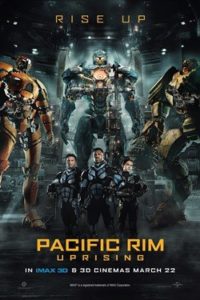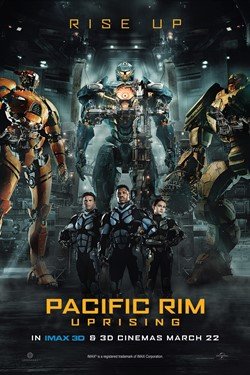Interview: The Digital Effects Geniuses of Halon Entertainment on “Pacific Rim: Uprising” and More
Posted on August 8, 2018 at 8:00 am

First of all, tell me the difference between what a previs and a postvis and visual effects supervision.
PETER CHIANG: I was on the production side so I supervise the film. I sit with Steven DeKnight and work out all the visual effects aspects of the film.
BRAD ALEXANDER: And so previs is where we come in at a very early stage and work with the director to translate the story in a very loose form using 3D animation and edit with as much constraint that we can put in as far as the lens used and how we’re actually going to get the shot.
RYAN MCCOY: After that, we take the film or movie so the principle photography happens. What we get back is a bunch of shots about a character reacting to a monster on a green screen but there’s no actual monster there.
They’re looking at a tennis ball, right?
RYAN MCCOY: Right, reacting to a tennis ball, so we have to make the tennis ball more frightening so that when you look at it in the context of the edit it makes sense and you get what is going on. That’s when postvis comes in. We’ve quickly put together a mock-up of what the final would be like and then the scene goes through iterations real fast without spending a whole lot of money so they can figure out if the scene works really quickly.
BRAD ALEXANDER: Postvis is almost a scaled down version of what a final visual effects shot is, probably it’s maybe 1/100th of the effort put in to convey what needs to be there.
PETER CHIANG: It’s a bit more than one percent. I think Brad is just being modest.
When the actors are looking at the tennis ball have they actually seen drawings of what it is they’re supposed to be looking at to help them create their performance?
BRAD ALEXANDER: Yes, on set we have the art department do amazing visuals to support that idea and we’ve already worked out really how high the robots are and so we’re counting floors on the building to talk to John Boyega and say “Hey, look, it’s going to be roughly about that high and he’s going to come at you from that way,” We do little tricks like we set up balloons and markers. We will put up two weather balloons and tell them to go A to B at a certain time. You’ll see him go like this and we go “No, no, no, no; he’s going to go like thiiisss” .
BRAD ALEXANDER: Or you fly a drone
I was very impressed with the believability of the weight and gravity that your Jaeger and Kaiju characters have and the physics of moving them around. What goes into making that work?
PETER CHIANG: We looked at a lot of things. We looked at lot of oil tankers and large objects moving. And so there was a tug of war constantly between physics and keeping the sequence alive and exciting. I think if we portrayed it in real physics people would have gone to sleep, because it would have taken a long time for that robot to walk down the street so there was a payoff. But even then we had to slow them down so on the set we would say to John and Cailee , “Hey look, you’re moving too quickly, you’ve got to feel like you’re lumbering a bit to slow him down”
BRAD ALEXANDER: At the very beginning when we were doing previs before we had the opportunity to work with Peter a lot of our shots and sequences to me personally just felt like they were moving so fast. It was frustrating. Coming from an animation background, you need to show weight. You need to show secondary motion. You want the plates to jiggle when you have a lot of mass. We kind of got cut off in the beginning phase of doing that and we had to send it off and let it go and then it’s kind of like I bowed my head and prayed to the Gods that someone would fix it. And then Peter came in and they actually fixed it so I think we found a middle ground that worked.
RYAN MCCOY: Yeah often in previs it’s hard because we have to cut down on all of the nuances of the animation and just the lightng and the contacts with the ground and a lot of those little things. That last five percent that polishes it off and makes the photo real is often what really gives it the weight that’s necessary. and so sometimes it can be challenging where it kind of looks okay in previs and then you do it in a final scene and when you see it, it’s like, “Oh well, that’s crazy.” So often what we have to do is put in a little extra work on some of those shots to really get it to sell, to start to understand how that weight would really work and how it would move and just the physics of it.
I was also impressed with the personalities of the different characters, particularly Scrapper who had a believably junkyard feel. I know some of that is from the sound guys but some of that is what you do.
BRAD ALEXANDER: The art department works very fast when they build their models and the model that they initially gave us looked like someone had taken a bunch of engine parts and panels from airplanes and whacked everything together. It wasn’t ribbed at all and I had to figure out — where are the joints going to go on this thing? Are there any gears that I can use as an elbow? Where are the hips going to be? I had to figure a lot of this kind of stuff out and then change some stuff around. Then I pass it off to the art department and say, “Can I move this? Is that okay?”
I think my favorite thing in this movie was that you got to play around with scale in such a dramatic way. We thought the last movie had very big creatures and big robots but now we’re in a whole other level. But you have to keep them all in the same shot, so how did you do that?
RYAN MCCOY: Wide lenses — put the camera really low with the wide lens and go back.
If I came over to your house is there anything I would see that would show that you worked on this project?
BRAD ALEXANDER: I got a Gypsy model from the first film and I had that on my desk the whole time. I have a little shelf in my house that has a little thing from a lot of the movies that I’ve worked on, my memento things.
Some people have pictures of their families…
BRAD ALEXANDER: I have robots.
RYAN MCCOY: Robot children.
PETER CHIANG: I love the toys. I’ve got all the toys; got the four main robots and Obsidian and Fury.
What are the qualities that make somebody very good at doing previs?
RYAN MCCOY: Being close to their inner child. Being able to embrace it while still being mature.
BRAD ALEXANDER: I think it’s generally a skill set. If you are as a 3D artist I think gives you the most to bring to the table as a previs artist because if you can rig a model, animate two effects, you could do everything and that opens you up to most work that we can give you.
RYAN MCCOY: Yeah for previs and postvis we really want filmmakers. We want people that understand storytelling not just people who know one skill particularly well. Alot of schools focus on just perfecting one specific craft and making a character feel very fluid in movement or whatever really is making one image look really beautiful and that’s all great — we need that too — but you can’t tell a story if you don’t know how you cut to one shot and all of a sudden it feels jarring and strange because you crossed the line or this is a weird framing of this creature or you don’t know what lenses are or how to use them effectively. There are so many tools.
BRAD ALEXANDER: Ultimately it’s film language and it all boils down to the composition, screen direction, and all of that kind of stuff.
What’s your next film coming out?
RYAN: He and I worked on “The Meg.” I have no idea if this is going to be good but it was a hell of a lot of fun to make. The whole end scene is what we worked on. And we did the whole ending of “Aquaman,” so that was quite a big endeavor.
Those scenes are underwater, which must be another challenge of physics calculations.
RYAN MCCOY: It was, I feel for Industrial Light and Magic, trying to make that come to life and I can’t wait to see what they do with it. it was a lot of fun to do previs for it because of the vastness of what was going to be told and it was just this big collaboration to try to get it into a really good shape so that it was really exciting. Yeah, the whole thing was fast and really fun.


